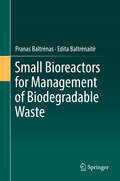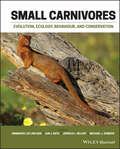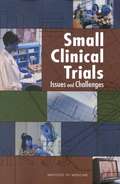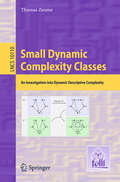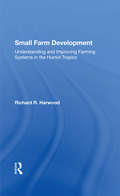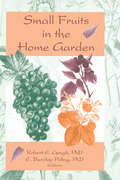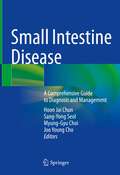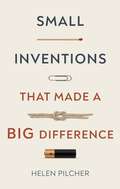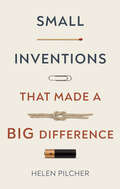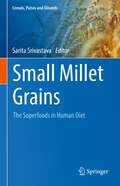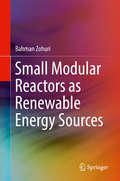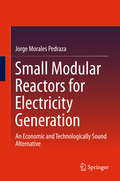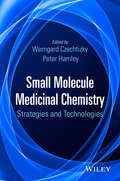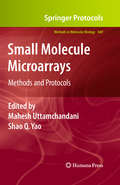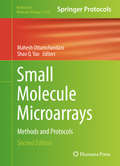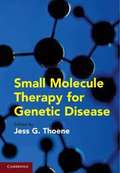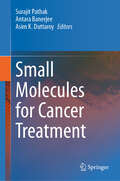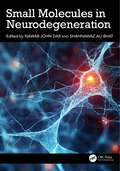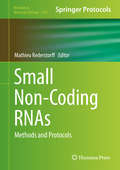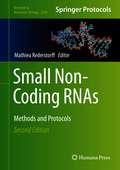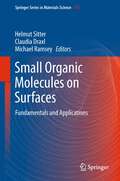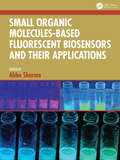- Table View
- List View
Small Bioreactors for Management of Biodegradable Waste
by Edita Baltrėnaitė Pranas BaltrėnasThis volume discusses how small bioreactors can produce useful biogas and compost from biodegradable waste. The authors identify which biodegradable wastes are optimal for small bioreactors, and how these choices can be used to increase bioreactor productivity. Additionally, readers will learn about how the amount and composition of biogas is estimated, the concentration of biodegradable waste that needs to be supplied to a bioreactor, the development of small bioreactors including the ratio of cost to the obtained benefits, and the nature of biodegradable wastes generated by both small farms and large food industry enterprises. The beginning chapters explain what biodegradable waste is, show how to predict how much waste an enterprise will produce, and elaborate the characteristics of the biogas which is generated from biodegradable waste in small bioreactors. Then the book discusses the types of small bioreactors and how to select the optimal bioreactor for a given case. Bioreactor performance is analyzed on both an economical and production efficiency basis, with experimental results provided on the quantity and quality of the biogas produced. The final chapters address how small bioreactors can be incorporated into small biogas plants, and the potential use of small bioreactors in countries with high demand for alternative energy using the case of Lithuania. The audience for this work includes specialists in biodegradable waste management and utilization enterprises, designers, and academics, researchers and students engaged in environmental engineering.
Small Businesses in the Aftermath of the Crisis: International Analyses and Policies
by Ilario Favaretto Giorgio CalcagniniThis book seeks to analyze how small and medium businesses react to the economic and financial crisis. Its focus is on the activities and strategies of SMEs in the areas of innovation, R&D investment, labor markets and finance. The book takes an international perspective and includes both comparative and national analyses and policies, with authors representing acdemia and international institutions such as the ECB, OECD, Kauffman Foundation, Federal Reserve, and US Small Business Administration.
Small Carnivores: Evolution, Ecology, Behaviour and Conservation
by Michael J. Somers Jerrold L. Belant Emmanuel Do Linh San Jun J. SatoSmall Carnivores: Evolution, Ecology, Behaviour, and Conservation This book focuses on the 232 species of the mammalian Order Carnivora with an average body mass "This is a book that has been needed for decades. It is the first compendium of recent research on a group of mammals which has received almost no attention before the early 1970s. This book covers a wide range of subdisciplines and techniques and should be considered a solid baseline for further research on this little-known group of highly interesting mammals. As our knowledge regarding how ecosystems function increases, then the valuable role of small carnivores and the necessity for their conservation should be regarded as of paramount importance. The topics covered in this book should therefore be of great interest not only to academics and wildlife researchers, but also to the interested layman." Professor Anne Rasa, Ethologist
Small Cetaceans of Japan: Exploitation and Biology
by Toshio KasuyaThis book summarizes and analyzes the biology, ecology, exploitation and management of small cetaceans in Japan. It describes the various types of cetacean fisheries in Japan and their historical development, the life histories and ecologies of the main species involved, and the history and problems of conservation and management. The data show that in some cases the number of small cetaceans harvested exceed sustainable limits and have led to depletion of populations. The book provides a case study of what can go wrong when the needs of industry and conservation collide. The descriptions of life history and ecology are relevant to issues of conservation and management, not just for cetaceans, but for all fisheries around the world.
Small Clinical Trials: Issues and Challenges
by Institute of MedicineProgress in areas of science such as biotechnology has resulted in the need for new approaches to optimization of the design and analysis of clinical trials when the number of experimental participants is unavoidably small. Clinical trials involving astronauts share characteristics with other types of small clinical trials. This study, commissioned by NASA, recommends approaches to the design, implementation, and evaluation of clinical trials with small numbers of participants. The study lacks a subject index. Evans is affiliated with the Institute of Medicine. Ildstad is director of the Institute for Cellular Therapeutics at the University of Louisville. Annotation c. Book News, Inc. , Portland, OR (booknews. com)
Small Dynamic Complexity Classes
by Thomas Zeume"Small Dynamic Complexity Classes" was awarded the E. W. Beth Dissertation Prize 2016 for outstanding dissertations in the fields of logic, language, and information. The thesis studies the foundations of query re-evaluation after modifying a database. It explores the structure of small dynamic descriptive complexity classes and provides new methods for proving lower bounds in this dynamic context. One of the contributions to the former aspect helped to confirm the conjecture by Patnaik and Immerman (1997) that reachability can be maintained by first-order update formulas.
Small Farm Development: Understanding And Improving Farming Systems In The Humid Tropics
by Richard R HarwoodThis book analyses several aspects of small farm production systems that increase efficiency when the farmer's production resources are limited. It is concerned with the goals of the individual farmer and his immediate family.
Small Fruits in the Home Garden
by Robert E Gough Edward Barclay PolingWhy plant a vegetable garden with the same old tomato and cucumber plants that everyone else has? Small Fruits in the Home Garden is your home gardener?s guide to growing and harvesting small fruit for personal enjoyment. The contributors to this book provide the necessary information and helpful hints for you to grow many new varieties of small fruits, that have wonderful flavor but may not be suitable for commercial production, right at home. Now you can harvest the tastiest varieties at their peak flavor! In Small Fruits in the Home Garden, you?ll see how small fruits can enhance not only your diet, but also your garden and landscape. You?ll learn how strawberry plants, for example, make wonderful perennial borders along paths and walkways and how currants, gooseberrries, and blueberries serve as “edible” hedges that are especially lovely in the summer when their branches are laden with colorful fruit. Each chapter of this unique handbook provides detailed background and growing information on a particular fruit, with special attention to:climatesoilpestswater tablepreplant operationsplantingmanagementpruningfertilizinglimingwateringSee how growing and harvesting small fruit can provide you with something nutritious and beautiful that doesn?t demand too much free time. With Small Fruits in the Home Garden, you, too, can easily manage and enjoy small fruit growing.
Small Intestine Disease: A Comprehensive Guide to Diagnosis and Management
by Hoon Jai Chun Myung-Gyu Choi Sang-Yong Seol Joo Young ChoThis book covers all aspects of small intestinal disease with the aim of providing an up-to-date reference of the highest quality that will assist in everyday clinical practice. After introductory chapters on anatomy, pathophysiology, epidemiology, and signs and symptoms, the roles of different imaging modalities in the diagnosis of small intestinal disease are clearly explained, focusing particularly on capsule endoscopy, device-assisted enteroscopy, CT and MR enterography, and nuclear medicine techniques. A series of chapters then address each of the diseases and conditions that may be encountered. The coverage is wide ranging, including, for example, obscure gastrointestinal bleeding, Crohn’s disease and other inflammatory conditions, celiac disease, Behçet’s disease, Meckel’s diverticulum, intestinal tuberculosis, and various malignancies. Numerous informative clinical cases are presented to identify characteristic imaging findings and assist in treatment decision making. Small intestinal disease continues to represent a significant challenge. The scope and detail of this book will make it an invaluable asset for gastroenterologists and other clinicians.
Small Inventions That Made a Big Difference: From Prehistory To The Present
by Helen PilcherPockets, matches, spectacles, postage stamps. Whether it's the stitches that hold our clothes together or the syringes that deliver life-saving vaccines, small things really do make a big difference. Yet these modest but essential components of everyday life are often overlooked.Science and comedy writer Helen Pilcher shares the unexpected stories of 50 humble innovations – from the accidental soldering of two bits of metal that created the pacemaker, to the eighteenth-century sea captain whose ingenious invention paved the way for the filming of Star Wars – and celebrates the joy of the small yet mighty.
Small Inventions That Made a Big Difference: From Prehistory To The Present
by Helen PilcherPockets, matches, spectacles, postage stamps.Whether it's the stitches that hold our clothes together or the syringes that deliver life-saving vaccines, small things really do make a big difference. Yet these modest but essential components of everyday life are often overlooked. Science and comedy writer Helen Pilcher shares the unexpected stories of 50 humble innovations - from the accidental soldering of two bits of metal that created the pacemaker, to the eighteenth-century sea captain whose ingenious invention paved the way for the filming of Star Wars - and celebrates the joy of the small yet mighty.
Small Inventions That Made a Big Difference: From Prehistory To The Present
by Helen PilcherPockets, matches, spectacles, postage stamps.Whether it's the stitches that hold our clothes together or the syringes that deliver life-saving vaccines, small things really do make a big difference. Yet these modest but essential components of everyday life are often overlooked. Science and comedy writer Helen Pilcher shares the unexpected stories of 50 humble innovations - from the accidental soldering of two bits of metal that created the pacemaker, to the eighteenth-century sea captain whose ingenious invention paved the way for the filming of Star Wars - and celebrates the joy of the small yet mighty.
Small Millet Grains: The Superfoods in Human Diet (Cereals, Pulses and Oilseeds)
by Sarita SrivastavaThis book discusses the various aspects of the health and nutritional benefits of the wonder grains, small millets. It introduces the readers to the historical use of small millet grains in the diet of humans. It further discusses the consumption and strategies to improve the global production of these nutrient-dense grains. The book outlines how the inclusion of small millet as a staple could prevent nutritional deficiency diseases, hidden hunger, and non-communicable diseases. Different chapters of the book provide information about the nutritional profile of popular small millet grains. It also includes information about the effects of processing on the dietary factors in the grains. It describes the traditional food products as well as unconventional products from small millet. It advises the readers on the best ways to consume this super-food. The book also highlights the role of small millet as a functional food. It highlights how this food can address the challenge of nutritional security.
Small Modular Reactors as Renewable Energy Sources
by Bahman ZohuriThis book highlights Small Modular Reactors (SMRs) as a viable alternative to the Nuclear Power Plants (NPPs), which have been used as desalination plant energy sources. SMRs have lower investment costs, inherent safety features, and increased availability compared to NPPs. The unique and innovative approach to implementation of SMRs as part of Gen-IV technology outlined in this book contributes to the application of nuclear power as a supplementary source to renewable energy. Discusses Gen-IV Power plants, their efficiency, cost effectiveness, safety, and methods to supply renewable energy;Presents Small Modular Reactors as a viable alternative to Nuclear Power Plants;Describes the benefits, uses, safety features, and challenges related to implementation of Small Modular Reactors.
Small Modular Reactors for Electricity Generation
by Jorge Morales PedrazaAs a flexible, cost-effective energy alternative to large scale nuclear power reactors, this book examines the potential future use of small modular reactors for the generation of electricity in different regions. Exploring advanced nuclear technologies, chapters describe the current situation and perspective of the small modular reactors market (SMRs) in different regions around the word, including North and South America, Europe, Asia, Middle East and Africa. Particular attention is paid to the benefits of using these types of reactors for the generation of electricity, discussing their efficiency and reduced construction time, as well as exploring the main difficulties encountered in the development stage. Looking at the potential dangers that SMRs pose to the environment and population, the text presents the new safety measures that have been adopted in SMRs design to reduce future risk.
Small Molecule Medicinal Chemistry
by Werngard Czechtizky Peter HamleyStressing strategic and technological solutions to medicinal chemistry challenges, this book presents methods and practices for optimizing the chemical aspects of drug discovery. Chapters discuss benefits, challenges, case studies, and industry perspectives for improving drug discovery programs with respect to quality and costs.* Focuses on small molecules and their critical role in medicinal chemistry, reviewing chemical and economic advantages, challenges, and trends in the field from industry perspectives* Discusses novel approaches and key topics, like screening collection enhancement, risk sharing, HTS triage, new lead finding approaches, diversity-oriented synthesis, peptidomimetics, natural products, and high throughput medicinal chemistry approaches* Explains how to reduce design-make-test cycle times by integrating medicinal chemistry, physical chemistry, and ADME profiling techniques* Includes descriptive case studies, examples, and applications to illustrate new technologies and provide step-by-step explanations to enable them in a laboratory setting
Small Molecule Microarrays
by Shao Q. Yao Mahesh UttamchandaniSmall molecule microarrays (SMM) were introduced just a decade ago in 1999 and, within a short space of time, have already established themselves as a vibrant, next generation platform for high-throughput screening. Small Molecule Microarrays: Methods and Protocols showcases a collection of contributions guiding researchers toward ways in which small molecule microarray technology may be deployed for multiplexed screening and profiling. Organized by the categories of small molecules presented on the microarrays, this detailed volume describes in-depth techniques for chemical libraries, peptide libraries, and carbohydrate microarrays. Written in the highly successful Methods in Molecular BiologyTM series, chapters contain brief introductions to their respective topics, lists of the necessary materials and reagents, step-by-step, readily reproducible protocols, vital tips on troubleshooting this often difficult technology, and advice on avoiding known pitfalls. Authoritative and cutting-edge, Small Molecule Microarrays: Methods and Protocols provides meticulous depictions of key hands-on experience and seeks to inspire a future generation of microarray practitioners to take this significant technology forward.
Small Molecule Microarrays
by Shao Q. Yao Mahesh UttamchandaniSmall molecule microarrays (SMM) were introduced in 1999 and within just a short span of time, have established themselves as a vibrant next generation platform for high-throughput screening. Small Molecule Microarrays: Methods and Protocols consolidates a significant collection of examples, which serve to guide researchers toward ways in which SMM technology may be effectively deployed for multiplexed screening, drug discovery and ligand identification. The volume is organized into three sections covering microarray fabrication, imaging modes, and discovery approaches. The chapters cover a range of small molecule library types, ranging from synthetic combinatorial libraries to peptide and carbohydrate libraries, with lessons and techniques that can be widely applied. Written in the highly successful Methods in Molecular Biology series, format, chapters include introductions of their respective topics, lists of the requisite materials and reagents, step-by-step and readily reproducible laboratory protocols as well as vital tips on troubleshooting and advice on avoiding known pitfalls. Authoritative and cutting-edge, Small Molecule Microarrays: Methods and Protocols provides meticulous insights into the successful applications of SMM, by experts in the field. Building on this collection of knowledge, the volume seeks to inspire a future generation of microarray practitioners to propel this significant technology to even greater heights
Small Molecule Therapy for Genetic Disease
by Jess G. ThoeneThoene summarises the substantial work that has been accomplished in the treatment of inborn errors of metabolism with simple molecules. This handbook will enable interested clinician scientists to rapidly survey the field, thus ascertaining what has been done as well as future directions for therapeutic research. Its important introductory chapters discuss the infrastructure of the field. The book closely analyses the cofactors used to augment the function of defective enzymes and the compounds that are able to utilise an alternative pathway in order to avoid the consequences of the metabolic block present in the patient. Among other therapies, the authors discuss the use of zinc and tetrathiomolybdate to treat Wilson's disease and the use of cysteamine to treat nephropathic cystinosis.
Small Molecules for Cancer Treatment
by Asim K. Duttaroy Surajit Pathak Antara BanerjeeThe book explores role of small molecules and peptides in cancer therapy, with a focus on (Aptamer-drug conjugates, Androgen Receptor and Tyrosine Kinase inhibitors, and Glycosylation inhibitors. Small molecule inhibitors targeting oncogenic pathways such as EGFR and PI3K inhibitors, Peptides in oral cancer such as Antimicrobial peptides, Cell Penetrating Peptides, Tumour targeting peptides, Natural small molecules with anti-cancer effects such as phenolic compounds, alkaloids, terpenoids and steroids, Phthalides and lectins, Peptides targeting the tumor microenvironment such as GM-CSF's, LAG3, PD 1, CCL2, CCR-5, CXCR4 inhibitors). An introductory chapter covers the foundation for understanding their significance in cancer treatment. The book delves into the versatility and precision of small molecules, highlighting their advantages in drug delivery and formulation strategies. It emphasizes the expansion of therapeutic horizons through small molecule peptides, shedding light on their potential in targeting tumor microenvironments and advancing cancer therapeutics. Additionally, the book discusses combination therapies and synergistic effects, offering a deeper understanding of integrating different therapeutic approaches. Furthermore, it addresses emerging trends, challenges, safety considerations, and the relevance of small-molecule inhibitors. This book provides a crucial update on the latest advancements and serves as a valuable resource for researchers, clinicians, and students interested in the rapidly evolving landscape of cancer treatment, offering an overview of the potential and complexities associated with these compounds in the fight against cancer.
Small Molecules in Neurodegeneration
by Nawab John Dar Shahnawaz Ali BhatNeurodegenerative diseases, like Alzheimer's, Parkinson's, and Huntington's, cast a long shadow over millions of lives, stealing memories, independence, and futures. The rising tide of these age-related disorders threatens to overwhelm healthcare systems worldwide, prompting an urgent search for effective treatments. While current options offer temporary relief, they fail to halt the relentless march of these devastating conditions. However, a beacon of hope shines at the intersection of cutting-edge neuroscience and the world of small molecules. These tiny chemical warriors, with their inherent advantages of cost-effectiveness, scalability, and diverse functionalities, are emerging as powerful weapons in the fight against neurodegeneration. This book stands as a testament to this increasing revolution. It investigates deep into the intricacies of small molecules, exploring their potential to unravel the mysteries of neurodegenerative diseases and pave the way for innovative therapeutic interventions.Key Features: Provides a comprehensive and accessible overview of the emerging field of small molecules in neurodegenerative diseases. Bridges the gap in current literature by addressing the specific impact of small molecules on these devastating conditions. Offers an in-depth exploration of the various mechanisms by which small molecules can combat neurodegeneration. Serves as a valuable resource for a wide audience, from students to professionals in the field. Lays the foundation for a deeper understanding of neurodegenerative diseases and unlocks new avenues for the development of effective therapies.
Small Non-Coding RNAs
by Mathieu RederstorffThis volume contains state-of-the-art methods tackling all aspects of small non-coding RNAs biology. Small Non-Coding RNAs: Methods and Protocols guides readers through customized dedicated protocols and technologies that will be of valuable help to all those willing to contribute deciphering the numerous functions of small non-coding RNAs. Written in the highly successful Methods of Molecular Biology series format, chapters include introductions to their respective topics, lists of the necessary materials and reagents, step-by-step, readily reproducible laboratory protocols and key tips on troubles troubleshooting and avoiding known pitfalls. Instructive and practical, Small Non-Coding RNAs: Methods and Protocols reaches out to biochemists, cellular and molecular biologists already working in the field of RNA biology and to those just starting to study small non-coding RNAs.
Small Non-Coding RNAs: Methods and Protocols (Methods in Molecular Biology #2300)
by Mathieu RederstorffThis second edition provides new and updated chapters detailing methods tackling all aspects of small non-coding RNAs biology. Chapters guide readers through customized dedicated protocols and technologies that will be of valuable help decipher the numerous functions of small non-coding RNAs. Written in the highly successful Methods of Molecular Biology series format, chapters include introductions to their respective topics, lists of the necessary materials and reagents, step-by-step, readily reproducible laboratory protocols and key tips on troubleshooting and avoiding known pitfalls. Instructive and practical, Small Non-Coding RNAs: Methods and Protocols, Second Edition aims to be a valuable help and of great interest to a large number of researchers working in the field of RNA or willing to develop RNA studies.
Small Organic Molecules on Surfaces
by Michael Ramsey Claudia Draxl Helmut SitterThis book deals with basic aspects of polymer electronics and optoelectronics. There is an enormous world-wide effort both in basic scientific research as well as in industrial development in the area of organic electronics. It is becoming increasingly clear that, if devices based on organic materials are ever going to have a significant relevance beyond being a cheap replacement for inorganic semiconductors, there will be a need to understand interface formation, film growth and functionality. A control of these aspects will allow the realisation of totally new device concepts exploiting the enormous flexibility inherent in organic chemistry. In this book we focus on oligomeric/molecular films as we believe that the control of molecular structures and interfaces provides highly defined systems which allow, on the one hand the study of the basic physics and on the other hand to find the important parameters necessary to improve organic devices.
Small Organic Molecules-Based Fluorescent Biosensors and their Applications
by Abha SharmaThis book provides an overview of organic molecule-based fluorescent compounds and their applications as sensors and biosensors. The initial chapter introduces fundamental fluorescence concepts and their significance in biosensing. The book, in turn, details the synthesis of various scaffolds including xanthene, BODIPY, julolidine, cyanine, quinoline, phenanthiridine, acridine, rhodamine, benzothiazole, coumarin, perylene, and carbazole. The subsequent section covers the use of these organic fluorescent molecules in sensing proteins and DNA through selective binding, ion indicators for real-time tracking, and receptor-specific ligands for interaction studies. It also explores cellular component visualization using organelle markers and membrane probes. Additionally, the book delves into the application of fluorescent organic molecules for sensing lipids, carbohydrates, and other biological molecules, fostering interdisciplinary understanding. Addressing environmental concerns, the book highlights the use of fluorescent probes for analyte analysis, providing insights into pollution monitoring and water quality assessment. This book is useful for researchers, students, and professionals seeking to understand and harness the potential of these innovative biosensing technologies.Key features Provides a comprehensive overview of the synthesis and development of organic molecule-based fluorescent compounds Presents applications of organic molecule-based fluorescent compounds in various aspects of biological and environmental analysis Discusses the applications of fluorescent compounds in sensing of lipids, carbohydrates, and other biological molecules Reviews the role of fluorescent probes in monitoring pollution and assessment of water quality Examines the role of biosensors as ion indicators for real-time tracking, and receptor-specific ligands for interaction studies Explores cellular component visualization using organelle markers and membrane probes
